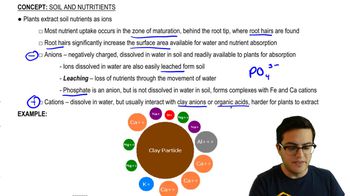Table of contents
- 1. Introduction to Biology2h 42m
- 2. Chemistry3h 40m
- 3. Water1h 26m
- 4. Biomolecules2h 23m
- 5. Cell Components2h 26m
- 6. The Membrane2h 31m
- 7. Energy and Metabolism2h 0m
- 8. Respiration2h 40m
- 9. Photosynthesis2h 49m
- 10. Cell Signaling59m
- 11. Cell Division2h 47m
- 12. Meiosis2h 0m
- 13. Mendelian Genetics4h 44m
- Introduction to Mendel's Experiments7m
- Genotype vs. Phenotype17m
- Punnett Squares13m
- Mendel's Experiments26m
- Mendel's Laws18m
- Monohybrid Crosses19m
- Test Crosses14m
- Dihybrid Crosses20m
- Punnett Square Probability26m
- Incomplete Dominance vs. Codominance20m
- Epistasis7m
- Non-Mendelian Genetics12m
- Pedigrees6m
- Autosomal Inheritance21m
- Sex-Linked Inheritance43m
- X-Inactivation9m
- 14. DNA Synthesis2h 27m
- 15. Gene Expression3h 20m
- 16. Regulation of Expression3h 31m
- Introduction to Regulation of Gene Expression13m
- Prokaryotic Gene Regulation via Operons27m
- The Lac Operon21m
- Glucose's Impact on Lac Operon25m
- The Trp Operon20m
- Review of the Lac Operon & Trp Operon11m
- Introduction to Eukaryotic Gene Regulation9m
- Eukaryotic Chromatin Modifications16m
- Eukaryotic Transcriptional Control22m
- Eukaryotic Post-Transcriptional Regulation28m
- Eukaryotic Post-Translational Regulation13m
- 17. Viruses37m
- 18. Biotechnology2h 58m
- 19. Genomics17m
- 20. Development1h 5m
- 21. Evolution3h 1m
- 22. Evolution of Populations3h 52m
- 23. Speciation1h 37m
- 24. History of Life on Earth2h 6m
- 25. Phylogeny2h 31m
- 26. Prokaryotes4h 59m
- 27. Protists1h 12m
- 28. Plants1h 22m
- 29. Fungi36m
- 30. Overview of Animals34m
- 31. Invertebrates1h 2m
- 32. Vertebrates50m
- 33. Plant Anatomy1h 3m
- 34. Vascular Plant Transport1h 2m
- 35. Soil37m
- 36. Plant Reproduction47m
- 37. Plant Sensation and Response1h 9m
- 38. Animal Form and Function1h 19m
- 39. Digestive System1h 10m
- 40. Circulatory System1h 57m
- 41. Immune System1h 12m
- 42. Osmoregulation and Excretion50m
- 43. Endocrine System1h 4m
- 44. Animal Reproduction1h 2m
- 45. Nervous System1h 55m
- 46. Sensory Systems46m
- 47. Muscle Systems23m
- 48. Ecology3h 11m
- Introduction to Ecology20m
- Biogeography14m
- Earth's Climate Patterns50m
- Introduction to Terrestrial Biomes10m
- Terrestrial Biomes: Near Equator13m
- Terrestrial Biomes: Temperate Regions10m
- Terrestrial Biomes: Northern Regions15m
- Introduction to Aquatic Biomes27m
- Freshwater Aquatic Biomes14m
- Marine Aquatic Biomes13m
- 49. Animal Behavior28m
- 50. Population Ecology3h 41m
- Introduction to Population Ecology28m
- Population Sampling Methods23m
- Life History12m
- Population Demography17m
- Factors Limiting Population Growth14m
- Introduction to Population Growth Models22m
- Linear Population Growth6m
- Exponential Population Growth29m
- Logistic Population Growth32m
- r/K Selection10m
- The Human Population22m
- 51. Community Ecology2h 46m
- Introduction to Community Ecology2m
- Introduction to Community Interactions9m
- Community Interactions: Competition (-/-)38m
- Community Interactions: Exploitation (+/-)23m
- Community Interactions: Mutualism (+/+) & Commensalism (+/0)9m
- Community Structure35m
- Community Dynamics26m
- Geographic Impact on Communities21m
- 52. Ecosystems2h 36m
- 53. Conservation Biology24m
35. Soil
Soil and Nutrients
Problem 2`
Textbook Question
Micronutrients are needed in very small amounts because
a. Most of them are mobile in the plant
b. Most serve mainly as cofactors of enzymes
c. Most are supplied in large enough quantities in seeds
d. They play only a minor role in the growth and health of the plant
 Verified step by step guidance
Verified step by step guidance1
Understand the role of micronutrients in plants: Micronutrients are essential elements required by plants in small quantities for various physiological functions.
Consider the mobility of micronutrients: While some micronutrients can move within the plant, their mobility does not determine the amount needed.
Examine the function of micronutrients as enzyme cofactors: Many micronutrients act as cofactors, which are non-protein chemical compounds that assist enzymes in catalyzing reactions.
Evaluate the supply of micronutrients in seeds: Seeds may contain some micronutrients, but this does not necessarily mean they are supplied in large quantities.
Assess the importance of micronutrients in plant growth and health: Despite being required in small amounts, micronutrients are crucial for plant growth and health, playing significant roles in various metabolic processes.
 Verified video answer for a similar problem:
Verified video answer for a similar problem:This video solution was recommended by our tutors as helpful for the problem above
Video duration:
2mPlay a video:
Was this helpful?
Key Concepts
Here are the essential concepts you must grasp in order to answer the question correctly.
Micronutrients in Plants
Micronutrients are essential elements required by plants in small quantities for growth and development. Despite their minimal presence, they play critical roles in various physiological processes, including enzyme function and photosynthesis. Deficiencies can lead to significant health issues in plants, affecting their growth and productivity.
Recommended video:
Guided course

Land Plants
Role of Micronutrients as Enzyme Cofactors
Many micronutrients act as cofactors for enzymes, meaning they are necessary for the enzyme's activity. These elements bind to the enzyme and assist in catalyzing biochemical reactions, which are vital for plant metabolism. Without these cofactors, enzymes may not function properly, leading to metabolic disruptions.
Recommended video:
Guided course

Cofactors
Mobility of Micronutrients in Plants
The mobility of micronutrients within a plant refers to their ability to move from one part of the plant to another. This mobility is crucial for distributing nutrients to areas where they are needed most. However, not all micronutrients are highly mobile, which can affect how deficiencies manifest and are addressed in plant care.
Recommended video:
Guided course

Sampling Mobile Organisms: Mark & Recapture
Related Videos
Related Practice






















